Bacterial Communities Show Algal Host (Fucus spp.)/Zone Differentiation Across the Stress Gradient of the Intertidal Zone
- PMID: 33072025
- PMCID: PMC7541829
- DOI: 10.3389/fmicb.2020.563118
Bacterial Communities Show Algal Host (Fucus spp.)/Zone Differentiation Across the Stress Gradient of the Intertidal Zone
Abstract
The intertidal zone often has varying levels of environmental stresses (desiccation, temperature, light) that result in highly stress-tolerant macrobiota occupying the upper zone while less tolerant species occupy the lower zone, but little comparative information is available for intertidal bacteria. Here we describe natural (unmanipulated) bacterial communities of three Fucus congeners (F. spiralis, high zone; F. vesiculosus, mid zone; F. distichus, low zone) as well as those of F. vesiculosus transplanted to the high zone (Dry and Watered treatments) and to the mid zone (Procedural Control) during summer in Maine (United States). We predicted that bacterial communities would be different among the differently zoned natural congeners, and that higher levels of desiccation stress in the high zone would cause bacterial communities of Dry transplants to become similar to F. spiralis, whereas relieving desiccation stress on Watered transplants would maintain the mid-zone F. vesiculosus bacterial community. Bacteria were identified as amplicon sequence variants (ASVs) after sequencing the V4 hypervariable region of the 16S rRNA gene. Microbiome composition and structure were significantly different between the differently zoned congeners at each tissue type (holdfasts, receptacles, vegetative tips). ASVs significantly associated with the mid-zone congener were frequently also present on the high-zone or low-zone congener, whereas overlap in ASVs between the high-zone and low-zone congeners was rare. Only 7 of 6,320 total ASVs were shared among tissues over all congeners and transplant treatments. Holdfast bacterial community composition of Dry transplants was not significantly different from that of F. spiralis, but Watered holdfast communities were significantly different from those of F. spiralis and not significantly different from those of procedural controls. Additional stressor(s) appeared important, because bacterial communities of Dry and Watered transplants were only marginally different from each other (p = 0.059). The relative abundance of Rhodobacteraceae associated with holdfasts generally correlated with environmental stress with highest abundance associated with F. spiralis and the two high-zone transplant treatments. These findings suggest that the abiotic stressors that shape distributional patterns of host species also affect their bacterial communities.
Keywords: Granulosicoccus; Octadecabacter; Rhodobacteraceae; desiccation; microbiome; peptide nucleic acid clamps (PNAs); transplant; zonation.
Copyright © 2020 Quigley, Capistrant-Fossa, Morrison, Johnson, Morozov, Hertzberg and Brawley.
Figures


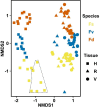
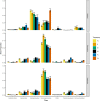

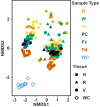

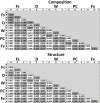
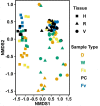

Similar articles
-
Alternative approaches to identify core bacteria in Fucus distichus microbiome and assess their distribution and host-specificity.Environ Microbiome. 2022 Nov 16;17(1):55. doi: 10.1186/s40793-022-00451-z. Environ Microbiome. 2022. PMID: 36384808 Free PMC article.
-
Adaptive traits are maintained on steep selective gradients despite gene flow and hybridization in the intertidal zone.PLoS One. 2011;6(6):e19402. doi: 10.1371/journal.pone.0019402. Epub 2011 Jun 14. PLoS One. 2011. PMID: 21695117 Free PMC article.
-
An expressed sequence tag analysis of the intertidal brown seaweeds Fucus serratus (L.) and F. vesiculosus (L.) (Heterokontophyta, Phaeophyceae) in response to abiotic stressors.Mar Biotechnol (NY). 2010 Apr;12(2):195-213. doi: 10.1007/s10126-009-9208-z. Epub 2009 Jul 17. Mar Biotechnol (NY). 2010. PMID: 19609612
-
The microbiome of the habitat-forming brown alga Fucus vesiculosus (Phaeophyceae) has similar cross-Atlantic structure that reflects past and present drivers1.J Phycol. 2021 Dec;57(6):1681-1698. doi: 10.1111/jpy.13194. Epub 2021 Jul 27. J Phycol. 2021. PMID: 34176151
-
Rhodobacteraceae on the marine brown alga Fucus spiralis are abundant and show physiological adaptation to an epiphytic lifestyle.Syst Appl Microbiol. 2017 Sep;40(6):370-382. doi: 10.1016/j.syapm.2017.05.006. Epub 2017 Jun 15. Syst Appl Microbiol. 2017. PMID: 28641923
Cited by
-
Alternative approaches to identify core bacteria in Fucus distichus microbiome and assess their distribution and host-specificity.Environ Microbiome. 2022 Nov 16;17(1):55. doi: 10.1186/s40793-022-00451-z. Environ Microbiome. 2022. PMID: 36384808 Free PMC article.
-
The Diversity and Functional Capacity of Microbes Associated with Coastal Macrophytes.mSystems. 2022 Oct 26;7(5):e0059222. doi: 10.1128/msystems.00592-22. Epub 2022 Aug 22. mSystems. 2022. PMID: 35993708 Free PMC article.
-
Functional Insights into the Kelp Microbiome from Metagenome-Assembled Genomes.mSystems. 2022 Jun 28;7(3):e0142221. doi: 10.1128/msystems.01422-21. Epub 2022 Jun 1. mSystems. 2022. PMID: 35642511 Free PMC article.
-
Functional prediction based on 16S rRNA metagenome data from bacterial microbiota associated with macroalgae from the Peruvian coast.Sci Rep. 2024 Aug 10;14(1):18577. doi: 10.1038/s41598-024-69538-6. Sci Rep. 2024. PMID: 39127849 Free PMC article.
-
Epibiont communities on mussels in relation to parasitism and location in the rocky intertidal zone.FEMS Microbiol Ecol. 2024 Aug 13;100(9):fiae101. doi: 10.1093/femsec/fiae101. FEMS Microbiol Ecol. 2024. PMID: 39138059 Free PMC article.
References
-
- Albuquerque L., Rainey F. A., Nobre M. F., da Costa M. S. (2011). Schleiferia thermophila gen. nov., sp. nov., a slightly thermophilic bacterium of the phylum ‘Bacteroidetes’ and the proposal of Schleiferiaceae fam. nov. Int. J. Syst. Evol. Microbiol. 61 2450–2455. 10.1099/ijs.0.028852-0 - DOI - PubMed
-
- Altamirano M., Flores-Moya A., Figueroa F. L. (2003). Effects of UV radiation and temperature on growth of germlings of three species of Fucus (Phaeophyceae). Aquat. Bot. 75 9–20. 10.1016/s0304-3770(02)00149-3 - DOI
-
- Baker S. M. (1909). On the causes of the zoning of brown seaweeds on the seashore. New Phytol. 8 196–202. 10.1111/j.1469-8137.1909.tb05523.x - DOI
-
- Baker S. M. (1910). On the causes of the zoning of brown seaweeds on the seashore. II. The effect of periodic exposure on the expulsion of gametes and on the germination of the oospore. New Phytol. 9 54–67. 10.1111/j.1469-8137.1910.tb05553.x - DOI
LinkOut - more resources
Full Text Sources
Miscellaneous

